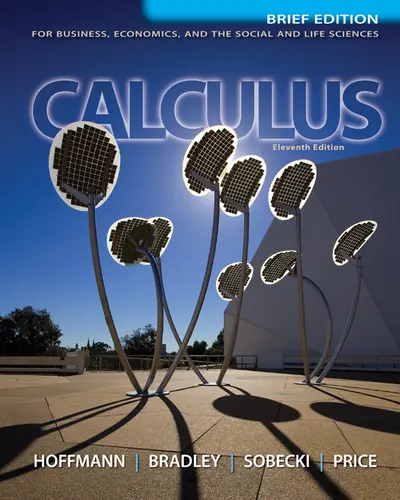Laurence Hoffmann
Laurence D. HoffmannNovember 2011I consider myself to be a writer and expositor as well as a mathematician, and these traits led to the original version of this text published in 1975. Before assuming my current position as a Senior Investment Management Consultant with Morgan Stanley Smith Barney, I was a tenured professor of mathematics at Claremont McKenna College, where, on three occasions, I was honored to be the recipient of the Huntoon Award for Excellence in Teaching, a “best-teacher” award determined by a vote of the students.In addition to my current profession and my ongoing involvement with this text, I serve on the Strategic Planning committee of the Claremont Community foundation and on the Investment Committee of the Rancho Santa Ana Botanic Gardens in Claremont.My wife, Janice, and I love to travel, enjoy music and the arts, have two grown sons, three grandchildren and two Maltese dogs. I am an avid (but average) tennis player, am addicted to the Sunday Puzzle on NPR, and have been trying for several years to become fluent in Italian.Long ago, I received by BA in mathematics from Brown University and my Ph.D. in mathematics from the University of Wisconsin.
Gerald Bradley
After receiving my undergraduate degree at Harvey Mudd College and my PhD from Caltech, I joined the Mathematics Department at Claremont McKenna College, where I have continued to teach, specializing in calculus, linear algebra, and differential equations. I love to write, and in addition to this text have written published texts on engineering calculus and linear algebra.My wife, Jaqui, and I are active supporters of recording textbooks for the blind and dyslexic. We also travel whenever we get a chance and especially enjoy cruising. Our favorite destinations have been Crete, Barcelona, and Singapore. I’m a lifelong Boston Red Sox, Los Angeles Lakers, and USC Trojan football fan, and write science fiction novels in my spare time. We have two sons, a newborn grandson, and seven cats, although it’s not clear whether we have the cats or they have us. We also raise foster kittens for a local shelter until they are ready to be adopted, and yes, three of our cats are fosters that we could not resist adopting ourselves.
David Sobecki
I was born and raised in Cleveland, and started college at Bowling Green State University in 1984 majoring in creative writing. Eleven years later, I walked across the graduation stage to receive a PhD in math, a strange journey indeed. After two years at Franklin and Marshall College in Pennsylvania, I came home to Ohio, accepting a tenure-track job at the Hamilton campus of Miami University. I’ve won a number of teaching awards in my career, and while maintaining an active teaching schedule, I now spend an inordinate amount of time writing textbooks and course materials. I’ve written or co-authored either seven or twelve textbooks, depending on how you count them, as well as several solutions manuals and interactive CD-ROMS.After many years as developmental math coordinator at Miami Hamilton, I share the frustration that goes along with low pass rates in the developmental math curriculum. Far too many students end up on the classic Jetson’s-style treadmill, with the abstract nature of the traditional algebra curriculum keeping them from reaching their goals. Like so many instructors across the country, I believe the time is right to move beyond the one-size-fits-all curriculum that treats students the same whether they hope to be an engineer or a pastry chef. “Because we’ve always done it that way” is NOT a good reason to maintain the status quo in our curriculum. Let’s work together to devise alternate pathways that help students to learn more and learn better while hastening their trip into credit-bearing math courses. Since my book (Math in Our World) is written for the Liberal Arts Math and Quantitative Literacy market, I think I’m in the right place at the right time to make a difference in the new and exciting pathways course.I’m in a very happy place right now: my love of teaching meshes perfectly with my childhood dream of writing. (Don’t tell my publisher this – they think I spend 20 hours a day working on textbooks – but I’m working on my first novel in the limited spare time that I have.) I’m also a former coordinator of Ohio Project NExT, as I believe very strongly in helping young college instructors focus on high-quality teaching as a primary career goal. I live in Fairfield, Ohio with my lovely wife Cat and fuzzy dogs Macleod and Tessa. When not teaching or writing, my passions include Ohio State football, Cleveland Indians baseball, heavy metal music, travel, golf, and home improvement.
Michael Price
Michael Price is a senior instructor and assistant department head of mathematics at the University of Oregon in Eugene, Oregon. Both his undergraduate and graduate degrees are from the University of Oregon, where has worked as a graduate student and instructor for the last 9 years. Michael has taught courses in introductory and intermediate algebra, up through precalculus, statistics, and three variations of calculus aimed at, respectively, biology/human physiology, business/economics, and mathematics/physical science students. As a coordinator for the precalculus sequence at the U of O and periodically other sequences required for non-math majors, Michael spends a substantial portion of his time developing and reinforcing responsible course material for mathematics service courses. In addition to this textbook, he has also contributed to supplemental materials and reviews of undergraduate texts in mathematics.
